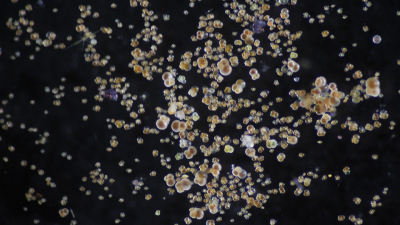- Home
- Discover
- Media Releases
- Media Releases 2022
- Evolution Forams
Colonization of microorganisms from the ocean floor into the water column
Microfossils play a central role in the study of past climate. Planktonic foraminifera store environmental conditions in their calcareous shells. When the organisms die, they sink to the ocean floor and are deposited in the sediment. Researchers use such sediment records as climate archives over millions of years.
Dr. Raphaël Morard and his colleagues have now molecularly analyzed a comprehensive data set. They conclude that the species living in the water column could be the result of a so-called species invasion from species living on the ocean floor.
"According to our evolutionary model, foraminifera are able to invade the pelagic habitat from the benthos. This model offers an explanation for several unresolved questions regarding the origin and evolutionary history of planktonic foraminifera," Raphaël Morard explains. The model also explains the biodiversity of foraminifera, he said, through colonization and not just extinction events and the subsequent evolution of species. Further research work on this is to follow within the framework of the Cluster of Excellence "Ocean Floor – Earth’s Uncharted Interface" based at MARUM.
Contact:
Dr. Raphael Morard
Micropaleontology - Paleoceanography
MARUM – Cener for Marine Environmental Sciences, University of Bremen
Phone: +49 421 218-65979
Email: [Bitte aktivieren Sie Javascript]
MARUM produces fundamental scientific knowledge about the role of the ocean and the ocean floor in the total Earth system. The dynamics of the ocean and the ocean floor significantly impact the entire Earth system through the interaction of geological, physical, biological and chemical processes. These influence both the climate and the global carbon cycle, and create unique biological systems. MARUM is committed to fundamental and unbiased research in the interests of society and the marine environment, and in accordance with the Sustainable Development Goals of the United Nations. It publishes its quality-assured scientific data and makes it publicly available. MARUM informs the public about new discoveries in the marine environment and provides practical knowledge through its dialogue with society. MARUM cooperates with commercial and industrial partners in accordance with its goal of protecting the marine environment.
Raphaël Morard, Christiane Hassenrück, Mattia Greco, Antonio Fernandez-Guerra, Sylvain Rigaud, Christophe J. Douady, Michal Kucera: Renewal of planktonic foraminifera diversity after the Cretaceous Paleogene mass extinction by benthic colonizers. Nature Communications 2022. DOI: https://doi.org/10.1038/s41467-022-34794-5



